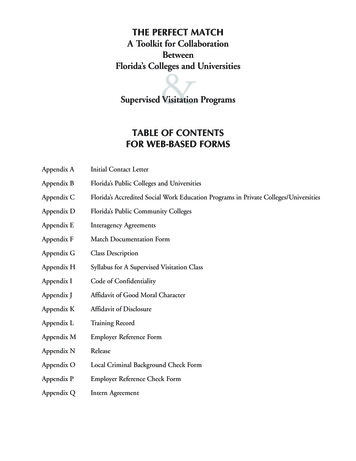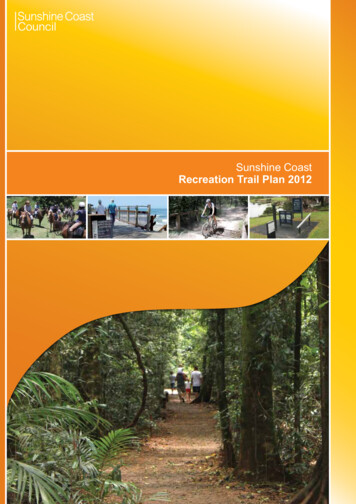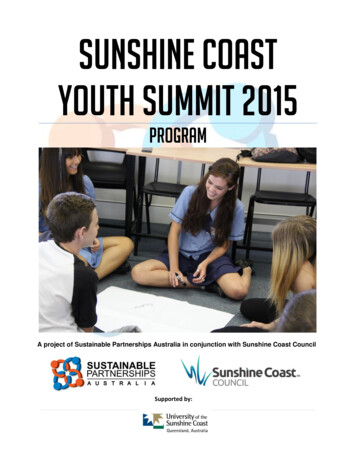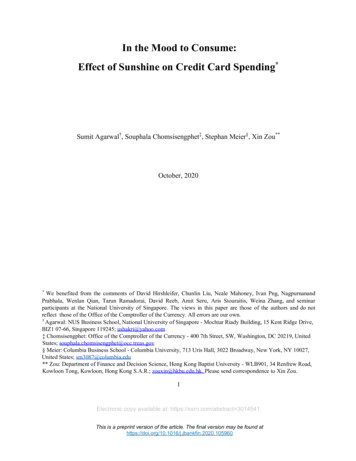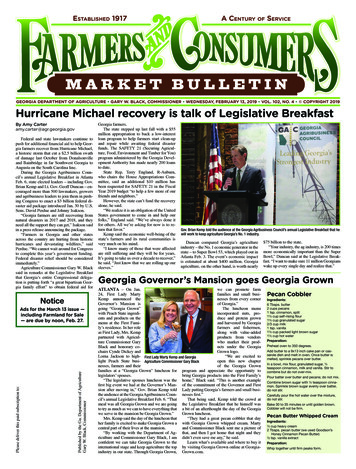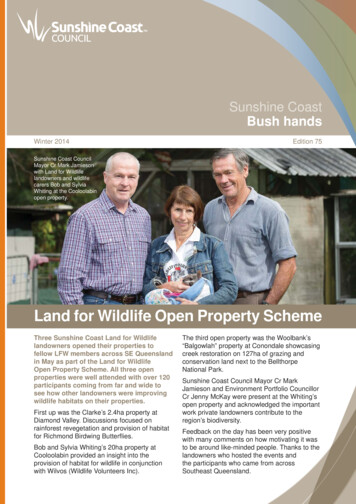
Transcription
Sunshine CoastBush handsWinter 2014Edition 75Sunshine Coast CouncilMayor Cr Mark Jamiesonwith Land for Wildlifelandowners and wildlifecarers Bob and SylviaWhiting at the Cooloolabinopen property.Land for Wildlife Open Property SchemeThree Sunshine Coast Land for Wildlifelandowners opened their properties tofellow LFW members across SE Queenslandin May as part of the Land for WildlifeOpen Property Scheme. All three openproperties were well attended with over 120participants coming from far and wide tosee how other landowners were improvingwildlife habitats on their properties.First up was the Clarke’s 2.4ha property atDiamond Valley. Discussions focused onrainforest revegetation and provision of habitatfor Richmond Birdwing Butterflies.Bob and Sylvia Whiting’s 20ha property atCooloolabin provided an insight into theprovision of habitat for wildlife in conjunctionwith Wilvos (Wildlife Volunteers Inc).The third open property was the Woolbank’s“Balgowlah” property at Conondale showcasingcreek restoration on 127ha of grazing andconservation land next to the BellthorpeNational Park.Sunshine Coast Council Mayor Cr MarkJamieson and Environment Portfolio CouncillorCr Jenny McKay were present at the Whiting’sopen property and acknowledged the importantwork private landowners contribute to theregion’s biodiversity.Feedback on the day has been very positivewith many comments on how motivating it wasto be around like-minded people. Thanks to thelandowners who hosted the events andthe participants who came from acrossSoutheast Queensland.
Focus on FloraNative HibiscusWhen we think of Hibiscus, we think ofthe classic exotic Queensland tropicalgarden flower, with a huge range ofcultivars and spectacular colours. However,along with these showy varieties, wehave five Hibiscuses that are native to theSunshine Coast.First up is the Cotton Tree Hibiscus tiliaceus.This is a beautiful hardy coastal tree that somepeople love and unfortunately some peoplelove to hate. They are robust and can produceprolific suckering and dense thickets that aregreat for stabilising estuarine riverbanks orcoastal foreshores. Mature trees produce thickhorizontal branches that are great to run aroundin and if your kids haven’t had the opportunity toclimb in a Cotton Tree they are missing out!Next up is the Swamp Hibiscus Hibiscusdiversifolius. Despite its name these are agreat, colourful fast growing plant for thegarden. Relatively short lived at only a yearor two, they grow quickly to between 1-2metres in coastal wetlands that are subject todisturbance. They produce masses of yellowflowers nearly 10cm across.Hibiscus heterophyllus flower2Sunshine Coast Council Bush hands Winter 2014with Spencer Shawof Brush Turkey EnterprisesFor speed of growth and colour you can’t gopast the Native Rosella Hibiscus heterophyllus,the Pink Hibiscus Hibiscus splendens andHibiscus divaricatus. All three of these shrubsof the open woodlands grow to between 2-6metres depending on conditions. The mostwidespread throughout the Sunshine Coastis the Native Rosella Hibiscus heterophylluswhich has white to pink 8cm flowers. The PinkHibiscus, Hibiscus splendens is less commonin our area and it has a tendency to develop arather bushy habit with huge 15cm pale pinkflowers. The Hibiscus divaricatus is the leastcommon throughout the region but is found in afew patches of open woodland and has yellow12cm flowers.Honeyeaters take advantage of the largenectar-rich flowers of species such as Hibiscusdiversifolius, Hibiscus heterophyllus andHibiscus splendens. While seed eaters likethe lorikeet feast upon the seed capsules ofHibiscus heterophyllus, insects seek out all fiveof the native hibiscuses.Hibiscus heterophyllus bud
Mangrove seed collecting – SeanFleischfresser and Zhane Currie onthe Maroochy RiverKerry Jones monitoringWater Mouse nests onthe Maroochy RiverMangrove Propagation Maroochy River IICultural Connections inCaring for CountryArticle by Kerry Jones, Helen Jones, Anne Miller, Sean Fleischfresser, Loretta Algar and Genevieve JonesImagine being an environmentalist butliving in a culture where you didn’t have toworry to any great degree about the loss oflocal biodiversity and rapid environmentaldecline. Across Australia this is howhundreds of millions people lived over thepast 60,000 years. While Landcare hadits beginnings 25 years ago (followed byBush Care, Coast Care and Caring for OurCountry and the like), it is often overlookedthat Aboriginal people and Torres StraitIslander people had specific and sustainablemanagement practices for land and water.These practices helped them retain thelegacy and heritage of one of the world’slongest living cultures here in Australia.Bill Gammage in his award winning book, TheBiggest Estate on Earth, describes the idea ofCaring for Country. ‘The (Aboriginal) Dreamingtaught why the world must be maintained,the land revealed how. One made land carecompulsory, the other made it rewarding’. Onewas spiritual and universal, the other practicaland local. Songlines distributed land spiritually;‘country’ distributed it geographically. Gammagealso states, ‘I venture that for Aboriginal peopleno land is natural; all is cultural’ and that ‘everyplace is filled with presences, rights and duties,making people life curators in two senses:bound for life to keep country alive. Someplaces may not be touched for years but notfor a moment did carers forget them. Sooneror later they patrolled every corner, burning,balancing, refreshing. Land care was the mainpurpose of life’ (Gammage 2011).Today many Aboriginal and Torres Strait IslandPeople are working to care for their traditionalestates and continue cultural practices tomaintain local biodiversity. Here on theSunshine Coast members of Bunya BunyaCountry Aboriginal Corporation are making theircontribution by undertaking a range of projectsthrough community partnerships. These includerevegetation, wildlife monitoring, and extendingawareness about the Aboriginal CulturalLandscape upon which we all live and work.Some of these projects include the MarooochyMangrove Nursery Project, the vulnerableWater Mouse (Xeromys myoides) mappingproject, the FarmFlow Riverbank RevegetationProject, water quality testing along theMaroochy Estuary and workshops in AboriginalCultural Heritage.Members of Bunya Bunya Country AboriginalCorporation include Kabi Kabi TraditionalOwners and historically connected AboriginalPeople from the Sunshine Coast. They arerecognised for their work in maintaining theirpeople’s cultural heritage and extending culturalawareness in collaboration with elders and thewider community.Bunya Bunya CountryAboriginal CorporationSunshine Coast Council Bush hands Winter 20143
Eastern Yellow Robin (E. chrysorrhoa) with the diagnosticyellow rump of this form found in our region, and alsoshows the yellow soles to the feetThe Eastern Yellow RobinEopsaltria australisArticle by Janet Whish-WilsonPhotos courtesy of Rob KernotForty years ago the name Eastern YellowRobin didn’t exist! There were two species,the Southern Yellow Robin (Eopsaltriaaustralis) and the Northern Yellow Robin(Eopsaltria chrysorrhoa) which wereregarded as separate species. Their size(15-16cm), habits and colouring with theirgrey heads and back and bright yellowbreast were alike but their rumps differed.The Northern species had a bright yellowrump while the Southern species wasolive-coloured.In late 1970 it was decided that the two specieswere conspecific and were to be regardedas one species known as the Eastern YellowRobin consisting of two races or two forms. TheNorthern race (E. chrysorrhoa) is present fromCooktown south to northern NSW where thereexists a certain amount of integration betweenthe northern and southern forms. Furthersouth the nominate race (E. australis) extendssouth into Victoria reaching SE South Australia(Tassie misses out). In WA the Western Yellow4Sunshine Coast Council Bush hands Winter 2014Robin and the White-breasted Robin areclosely related, belonging to the same genus,Eopsaltria.The Eastern Yellow Robin inhabits a variety ofenvironments such as rainforests, wet eucalypt,scrubby and wet gullies, ranges, paperbarkand coastal woodlands and parks. Crucialto their survival in all these environments isthe presence of a substantial middle to lowerunderstory. If either of these vegetation layersare overly cleared or destroyed there can bea serious decline in the presence of EasternYellow Robins.Like most of the Robin Family they are friendlylittle birds and will tolerate some humanpresence. They have a very inquisitive natureand will arrive to investigate unusual soundswatching quietly from a nearby branch.Similarly, they seek out their prey from vantagepoints on branches or clinging sideways on thetrunks of a tree, scanning the ground with keeneyes for any small insects or ground spiders
among the leaf litter or grassy areas. Whenthey spot movement they dart to the groundand snatch their prey then fly immediately to asafe branch to devour their catch.Their monotone call of a clear piping whistlecan be heard early morning and evening andoccasionally on an overcast day. It is generallythe first call to start the dawn chorus, hence themeaning of Eopsaltria – “dawn singer”. At timesthey utter harsh scolding notes. Another callheard in the evening consists of two or three“tewp-tewp” finished by a sharp whistle with atail flick and a wing drop. I love to hear this callwhen the robins come into my garden in thetwilight when they take the opportunity to catchsome tasty morsels safe from their predatorswho have retired to their night roost. Throughthe fading light I can just make them out dartingdown for insects in the grass – what sharp eyesthey must have. They have a long day beingthe last to settle for the night despite being upat dawn.There is also another call which is heard fromlate June until November which is a repetitivesharp two-noted call of “chop-chop” which startsup under the cover of dark and continues for20 minutes non-stop then ceases suddenlyjust as the first glow in the sky heralds the day.Sometimes a second caller will join in makingthe bush resonate with these fascinating callswhich seem to be associated with the robins’breeding season. When I first came to live nearmy little patch of bush this call mystified me.It would wake me every morning but due tothe lack of light I was never able to locate thesource. Then one evening I heard the call andcrept towards the sound and there on a branchto my surprise was the Yellow Robin with hislittle body throbbing with the effort and flickinghis tail on each “chop chop”.Both sexes are similar in plumage colourand pattern but the female is slightly smaller.Juvenile Eastern Yellow Robins are dark brownwith pale streaks, while the young adultRobins are slightly duller than the parents.Their cup-shaped nest is placed in a vine ora low tree fork beautifully constructed of bark(paperbark if handy) and dry fibre bound withspider web and lined with soft leaves withexternal decorations of patches of bark andlichen. The male feeds the female while sheincubates the eggs on the nest; and togetherthey raise the nestlings – usually two or three.After each feed the parent will stop for amoment to collect the gelatinous faecal sac,excreted by the young and then dispose of itaway from the nest. Nature is wonderful!The other resident Robin in this region is thePale-yellow Robin (Tregellasia capito) presentin dense rainforests in the low to middlecanopies. At 13cm it is smaller than the EasternYellow Robin and although not closely relatedthey do share many characteristics such asquiet friendly natures, clinging to tree trunkswhile searching for insects and similar nestconstruction etc.Our lovely Yellow Robins give such characterto our environment. Let’s hope enough suitablehabitat survives to keep them here always.Eastern Yellow Robin (E. chrysorrhoa)Pale-yellow Robin (Tregellasia capito) has differentcoloured legs and feet to that of the Eastern Yellow RobinSunshine Coast Council Bush hands Winter 20145
Cordyline manners-suttoniae – Endemic north from Gladstoneand a potential invasive weed in South East QueenslandPalm liliesArticle by Nadia JoyceCordyline is a genus of 15 species in thefamily Asparagaceae native to the westernPacific Ocean region, from New Zealand,eastern Australia, southeastern Asia,Polynesia and Hawaii.Eight species of Cordyline are native toAustralia: Cordyline cannifolia Cordyline congesta Cordyline fruticosa Cordyline manners-suttoniae Cordyline murchisoniae Cordyline petiolaris Cordyline rubra Cordyline strictaRed Fruited Palm LilyCordyline rubra (The species name is from theLatin ruber “red”)Height – to 4m tallLeaf – straplike leaves, narrow elliptic in shape15-50cm long by 3-4.5cm widePetiole – slightly concave petioles between 5and 20cm longFruit – bright scarlet about 1cm in diameterFlower – purplishDistribution – It grows naturally in rainforestand wet open forest, sometimes in sandysoils, from south-eastern Queensland to northeastern New South Wales (from Bundabergto Lismore). It is often seen growing alongsideCordyline petiolaris, with which it sometimeshybridises.Of these, two naturally occur on the SunshineCoast; Cordyline, petiolaris and Cordyline rubra.Recently I have noticed Cordyline mannerssuttoniae coming up in weedy proportionswithin a few reserves on the Sunshine Coast.Cordyline manners-suttoniae is similar inappearance to Cordyline petiolaris and makesme wonder if it may have been planted bymistake. Cordyline manners-suttoniae naturallyoccurs from Cooktown to Gladstone. A fewslight differences in leaf shape and petioleshape and size can help to tell the two apart.It is a concern that these two species couldhybridize, making it even more difficult todetermine which is which.Cordyline; from Greek cordlye, a swelling,referring to the swelling on the stems of somespecies.6Sunshine Coast Council Bush hands Winter 2014Cordyline rubra
Broad Leaved Palm LilyCordyline petiolaris (petiolarlis; from Latinpetiolaris, a petiole or leaf stalk, referring to thelong petioles of the species)Height – to 5m tallLeaf – deep glossy green leaves 45-85cm longand 6-15cm wide. They can be quite frayed atthe tips.Petiole – distinctive in-rolled petiole between30 and 50cm longFruit – red 0.7 to 1cm diameterFlower – clusters of white to pale lilac flowerson upper leaf axils in winter and springDistribution – South-eastern Queensland andnorth-eastern New South Wales (south-west ofGladstone to about Kempsey) in wet eucalyptforest and rainforest.Cordyline petiolarisSeventeen Seventy Palm LilyCordyline manners-suttoniaeHeight – to 4m tall, sometimes branchedLeaf – leaves 35-65cm long by 6-12cm wide.Veins longitudinal widely spaced. A noticeablefeature is the older leaves developing yellowedges towards the top section of the leaves.Petiole – 12-30cm longFruit – red 1 to 1.5cm diameterFlower – whitish; stalks 7 to 12mm longDistribution – Grows naturally in swamp forestand rainforest from Cooktown to Gladstone.GET OUTSIDE AND HELP OURNATIONAL PARKS!ECOllaboration is seeking expressions ofinterest for volunteers with the Friends ofParks initiative. Volunteering opportunitiesare available throughout the Sunshine andFraser Coasts for campground hosts, adopta track maintenance and weed control,visitor centre management and nurserymanagement.Cordyline manners-suttoniaeThis is a new program with Qld NationalParks that will enable volunteers to helpmanage our beautiful National Parks andforests. The program provides full trainingand volunteering opportunities for allexperience levels and ages. There are alsoopportunities for corporate volunteeringand community group involvement. Whereapplicable there is free camping, bargetransfers and driving permits.To register your interest, email JacquiSmythe at jacqui@ECOllaboration.org.au,phone 07 5313 4059 or visit riends-of-parks/.Sunshine Coast Council Bush hands Winter 20147
Powerful OwlsArticle by Kon HepersA few times a year we are woken up at nightby the deep, resonant “hooo-hooo” call ofa pair of Powerful Owls. Despite searchingwith torches we have never managed to seethem at our place.Just recently we were down in Sydney, stayingin a suburb adjacent to a very large tract ofcoastal forest. On one of the nights we againheard the “hooo-hooo” call of the PowerfulOwl. The next day it was twilight before I had achance to walk into the bush. Already it was toodark to see much. At one point I thought to lookup into the canopy of a tall eucalypt and thoughtI could see a symmetrical shape up there,darker than the bunched canopy. No witness,no torch, no camera!By the time I had walked back and collectedmy witness and camera (no torch available) itwas very dark but we found the tree again andMaureen confirmed the sighting and pointedout that there was a second large bird in thenext tree. Through the camera view-finder andscreen everything just looked black. But not towaste an opportunity I pointed the camera inapproximately the right direction with Maureenalongside giving guidance: “more to the right –a bit more – no, a bit to the left” etc. All up out ofabout 30 flash shots taken, only one was clearenough to prove it was indeed an owl.The next morning we went back and could justmake out an owl sitting in the same position(it was still quite gloomy in there) so we tooka few more shots. Again, only one image wasrelatively clear and showed that overnight theRing-tail Possum population had been depletedby one.Powerful Owls are skilful hunters8Sunshine Coast Council Bush hands Winter 2014
Powerful Owls, Ninox strenua, have a bodylength of 600 mm or more with a formidablespan of rounded wings up to 1400 mm. Assuch they are by far our largest owl and atop nocturnal predator. The Powerful Owl is acarnivore, eating mainly medium to large treedwelling mammals, particularly the CommonRingtail Possum and the Greater Glider. It isestimated that these owls will eat between 250and 350 possums in a year.(Ninox is a composite word meaning hawk-owl,strenua means vigorous). They are not relatedto the diurnal raptors but have similar featuresin strong, curved beaks and powerful talonsfor seizing and tearing apart their prey. Theyhave relatively small heads especially whencompared to the second group, the Maskedowls (genus Tyto), which have large facialdiscs rimmed with short stiff feathers, like weassociate with owls in general.The owls hunt via hearing and sight, glidingthrough the trees, snatching prey from thecanopy and mid-storey. The soft edges on theflight feathers allow it to fly in silence. RoostingBrush Turkeys and Flying-foxes are taken thisway. Terrestrial animals like rabbits, bandicootsand rats (even cats) are also hunted. Usuallythe victims’ heads are bitten off and eaten first.After digestion the remnants are disgorged aspellets composed of fur and feather. Small preyis swallowed whole.The double “hooo” call of the Ninox groupespecially that of the Powerful Owl is probablythe only “traditional” owl call among Australianspecies. The calls of genus Tyto are shrieks,screeches and loud hisses. We think thecalls we heard that led us to observe thesemagnificent birds were territorial calls in thelead-up to mating season, which is May toOctober. It is interesting that Neville W. Caley,the ground-breaking Australian ornithologist, inall of the many editions of his iconic book “WhatBird Is That” (the first field-guide of Australianbirds) describes the call of the Powerful Owl asa “hideous scream”. This is not correct.There are nine species of owls on mainlandAustralia. Powerful Owls belong to the group(four species) called Hawk-owls, genus Ninox.Powerful Owls, Ninox strenua is dark grey to darkgrey-brown above, with white barring, and off-white below,with distinctive dark v-shaped chevrons. The eyes areyellow, set in a dark grey/brown facial mask. The legsare feathered and the yellow to orange feet are massive,with sharp talons.Powerful Owls pair for life. They utilise anumber of roosting trees, generally talleucalypts. For nesting they require a large,deep hollow very high in an old tree, where thefemale lays and incubates one or two eggs.The male’s task is on-going food supply forthe female and later also for the chicks whichare hatched in about five weeks and fledged inanother eight weeks or so. The same hollow isused every year. Such large birds also requirean extensive hunting range of up to 1000hectares per pair. Habitat is varied but favourswet and dry sclerophyll forests, also rainforestsand coastal forests The Powerful Owl hasa distribution range across south-easternAustralia, mainly east of the Great DividingRange from about Mackay to the southern SAand Vic border.Sunshine Coast Council Bush hands Winter 20149
Tuans need connectionsArticle by Susie Duncan Coordinator, Hinterland Bush LinksTuans are beautiful little bushy-tailedmarsupials that hang out in eucalyptforests. Their other name is Brush-tailedPhascogale, so-called because their tailhair stands on end like a bottle-bushwhen they are alert. Tuan is the indigenousname for these animals and they have agreat life story. What a delight to hear thatSunshine Coast Council has named oneof their recently acquired land parcelsthrough the Environment Levy Acquisitionprogram after this forest dweller – TuanEnvironmental Reserve at Cambroon in theUpper Mary Valley.The reserve is home to the Tuan as well asthe rare Rufous Bettong and the threatenedGlossy Black-Cockatoo, Koala and Blackbreasted Button-Quail. It also protects criticallyendangered Lowland Rainforest and otherimportant habitat. The acquisition of thisproperty under the Environment Levy programconsolidates the region’s largest core habitatarea which also forms part of a bioregionalcorridor that runs from Maleny National Parkacross private land to Imbil and the WalliState Forests. Hinterland Bush Links andlocal landholders have also been focusing onrestoration of habitat in this corridor over thepast three years, performing weed managementand revegetation on public and private land.greater management outcomes for the Tuan.This little carnivore is similar to an Antechinusbut about four times bigger. Depending on howmuch tucker is around it can range over a forestarea of up to 100 ha and each individual willuse many different tree hollows for shelter. Sothey need a lot of continuous forest with largehollow-bearing trees to support a population.Fortunately the Conondale National Parkprovides this habitat.On the Blackall Range forested land is muchmore fragmented so the best way to ensurethere is enough habitat for this species is toconnect up the fragments. This is particularlyimportant for the Tuan because every year theentire male population dies after a testosteronefuelled mating frenzy. If breeding fails in anisolated patch of bush because of droughtor fire, the species will die out. The only waythat bush can be recolonised is if there isconnectivity to more extensive and resilientforest areas.When planning restoration on your own landyou might like to consider how you can connecthabitat with your neighbours or an adjacentreserve to ensure a future for Tuans andall our other wonderful wildlife. Recently 18volunteers had the opportunity to help protecttheTuan Environmental Reserve through therevegetation of essential habitat.Through strengthening and building greaterlandscape connectivity we can work to achieveBrush-tailed Phascogale in a nest box.Photo courtesy of Eileen Collins10Big Day Out at Tuan Environmental Reserve –volunteers help to buffer one of the main watering holesSunshine Coast Council Bush hands Winter 2014
The Sleeping GiantArticle by The SEE sub-group (Silva, Estelle, Edwin) of CDCCAs part of Noosa Parks Association’scaretaker commitment to QueenslandParks and Wildlife Services (QPWS), three‘weeders’ from Coolum District CoastCare recently enjoyed a weeklong working‘holiday’ at the light house keepers cottagesat Double Island Point, in the Cooloolasection of the Great Sandy National Park.In addition to undertaking weed eradication inthe assigned areas, the ever vigilant weedersnoticed a flourishing growth of Gloriosa Lily(Gloriosa superba) amongst trees quite nearthe cottages. A rather curious characteristicthat we noted was that whilst these plants hadsubstantial upper growth, no seeds or spentseed capsules were found. This may havebeen as a consequence of the lack of summerrain this year. Could it be that the plant waspreserving itself for another day? Unusual tosay the least as drier times usually trigger asurvival response from plants which brings fortha proliferation of seed.The showery weather ruled out the use ofchemical control on any of the weedingareas. So not being deterred by the onset ofintermittent showers, we decided to attack theGloriosa, as we could beat a hasty retreat tothe cottage should the rain intensify. So withgreat determination, we set about to hand digthe tubers in an attempt to TOTALLY removethe patch of Gloriosa. Protective gloves were amust during this exercise as the sap from thevines and tubers has been reported to be a skinirritant and quite toxic.Hand digging required that every stem was‘tracked’ back to a tuber. It was a painstakingbut worthwhile process because it providedcertainty that ALL offending tubers wereremoved and safely bagged. This requiredgreat care, as anyone who has tackled Gloriosa‘Weeders’ in actionReassembled Gloriosa plant, note the scale, provided bymatch sticks. This photograph represents some 2-3 hoursof careful removal.knows, the stem and tubers are quite fragileand break off easily.This process was not without a surprise or two.Not only was the length and thickness of sometubers rather substantial but they were alsomulti-layered, at about 5cm and then deeper upto 15-20cms below the surface. This suggeststhat the infestation of Gloriosa had existedfor several years. One of the most disturbingaspects was the extent of the network ofconjoined tubers that had spread underground.Sunshine Coast Council Bush hands Winter 201411
Events calendarEventJulyDetailsContactSunday 6 July10.00am – 11.30amPoint ArkwrightDiscovering Beach & Ocean Life – Understand our turtles,sharks and whales. Learn how sea urchins, starfish and seacucumbers move, eat and survive. Look closer in rock poolswith experts to spot shells, plants and animals.Children must be accompanied by adults.Riparian Roving – A bus tour of Upper Mary RiparianRevegetation Sites. Join the bus at Gympie 7am or Eumundi8am to meet at Maleny at 9am, rolling on down to Conondaleand on to Belli Park. Return to Maleny and Gympie. Learnabout riparian revegetation, considerations & techniques.Queensland Garden ExpoSchools National Tree DayBirds and their Calls presented by Gail Hill. 66pp – private landholder & community 88pp – government & businessNational Tree DayParklands and MarcoolaLiving with Wildlife – Experience native animals (includingsnakes) up close and personal then join Coast Carersplanting trees on National Tree Day.Children must be accompanied by adults.Geology and Rocks of the Sunshine Coastpresented by Warwick Wilmott and Phil Moran.Held at the Rural Futures Centre, Pomona.Register at www.coolumcoastcare.org.auFor more information phone 0406 605 700or email eco@coolumcoastcare.org.auLimited spaces. Gold Coin Donation.Friday 11 July9.00amAll day event11 – 13 JulyFriday 25 JulyFriday 25 July10.00am – 3.00pmReesvilleSunday 27 July9.00am – 11.00amSunday 27 July10.00am – 11.30amThursday 31 July5.00pm – 7.00pmRSVP by Friday 27 June to MRCCC atadmin@mrccc.org.au or 5482 4766 or toBrush Turkey Enterprises at education@brushturkey.com.au or 5494 3642Morning tea, lunch, afternoon tea anetark.org/aboutFor info and bookings contact Karen ateducation@brushturkey.com.auMorning tea and lunch provided.Visit the website for more ter at www.coolumcoastcare.org.auFor more information phone 0406 605 700or email eco@coolumcoastcare.org.auLimited spaces. Gold Coin .php RSVP to 5485 2468 or info@noosalandcare.orgAugustSunday 10 AugustLions Park, David LowWay at Margaret Street,CoolumSaturday 16 August8.00am – 3.30pmLondon CreekEnvironmental Reserve17 – 31 AugustThursday 28 August5.00pm – 7.00pmSaturday 30 August10.00am – 12.00pmSunday 31 August9.30am – 1.30pmMaroochy RegionalBotanic GardenSunday 31 August10.00am – 11.30amApex Camp, 171 NojoorRd, MudjimbaBugs, Bees and Butterflies – See native bees, learn aboutbutterfly corridor and touch some amazing creatures.Presented by Michelle Gleeson and Native Bee Rescuers.Children must be accompanied by adults.Sunshine Coast Conservation Field Day – A myriadof environmental hands-on technical sessions includingfauna monitoring & assessments, cultural heritage, plantidentification walks, weed management techniques,herbicide use and numerous restoration approaches.Sunshine Coast Wildflower FestivalVarious locations as per programForestry – Carbon and Biodiversity presented by MichelleHaase (BMRG) and John Meadows (Forestry ResearcherUSC) at the Rural Futures Centre, PomonaBasket Weaving with Cats Claw CreeperLocal artist Kris Martin will show us how to weave basketsfrom environmental weed vines. All materials supplied. 40 Members, 50 Non-members.Native Bees – Join Rob Raabe and members of the NativeBee Rescue Group in this practical session exploring theworld of native stingless bees. Help save our native beesand understand the integral role they play in maintaining ournatural environment. Maximum 50.Shorebirds and Backyard Birds – Learn about birdjourneys and how birds live and behave. Then become birddetectives spotting birds, nests and feathers.Children must be accompanied by adults.Register at www.coolumcoastcare.org.auFor more information phone 0406 60
along with these showy varieties, we have fi ve Hibiscuses that are native to the Sunshine Coast. First up is the Cotton Tree Hibiscus tiliaceus. This is a beautiful hardy coastal tree that some people love and unfortunately some people love to hate. They are robust and can produce prolifi c suckering and dense thickets that are
